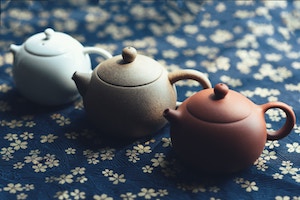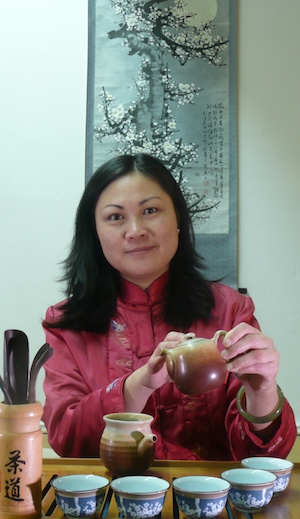 You can drink Kung Fu Cha in a small separate group or even together with everybody around. As a rule, it is relatively formless. You just try, with whomever, to join in a quiet place selected for the occasion and create a relaxed, recreative space for a more or less communicative pastime according to your preferences – solely aided by specially assorted teas and the necessary tea utensils.
You can drink Kung Fu Cha in a small separate group or even together with everybody around. As a rule, it is relatively formless. You just try, with whomever, to join in a quiet place selected for the occasion and create a relaxed, recreative space for a more or less communicative pastime according to your preferences – solely aided by specially assorted teas and the necessary tea utensils.
There are well-known strict forms of tea tasting in society, as for example the Japanese Cha Dos. – Here, every move, every accessory, sometimes even the content of the conversation is perfectly arranged in a disciplined way. Since the 1990s, “Chinese tea ceremonies” – if they exist at all – were heavily influenced by this Japanese formality of the way of tea. The more original Kung Fu Cha stresses the aspect of letting go, the disengaging from mundane life, which is oriented along Buddhist and Daoist practices. Together, you share your time, you enjoy the tea and sensuous talk, you appreciate the nice and friendly society and are really looking forward to meeting again soon for another tea. As letting go is not easy, this pastime has historically been a privilege of the elder people. They, having accomplished their share of work on the fields over a lifetime, did have enough time to cherish the pleasures of such moments with a good tea. In Taiwan, you can therefore hear “lao ren cha” (old people tea) being used as a synonym for “Kung Fu Cha”.
Practical tips for the preparation of a Kung Fu Cha session
The following elements are essential for the organisation of a Kung Fu Cha session:

- Some good and interesting teas: exquisite highland Oolong teas or medium fermented smooth Oolong teas are a good choice for drinking together in a group. The types of tea best to use as a rule are mild concerning the caffeine characteristic, but at the same time contain very pleasant flavours due to the natural way of preparation.
- Tea tableware, which is assembled matching the mood and the invited guests; your main focus should be directed at functionality, enjoyable visual appearance and hygiene.
Cooker, coal-burning stove or water boiler which allows to adjust the temperature depending on the needs of the tea as defined by its flavour, fermentation, roasting, freshness, storage. - Drinking water which should be soft, i.e. not contain too much chalk.Often spring water is sworn upon as a perfect choice, but the choice of the adequate water for a tea should be guided by one’s own practical experience and liking.
- The host or tea preparer should cater for an inviting atmosphere. A good tea session roots in naturalness – all happens as it is convenient at this point in time – talking or remaining silent as one sees fit. Generally, before preparing and passing around the tea, the tea leaves are handed round to invite the guests to examine its appearance and its flavour as a group and to share impressions. After this, the preparation and tasting begins.
- There are not any rules as to how many and which types of tea should be tasted. However, an experienced host will be able to notice the mood of the guests. Accordingly, she or he will accordingly stop slowly and relaxedly to pour more tea or maybe change the type of tea to loosen the atmosphere.
Author: Yi-Chun Hwang
Translation: Taiji Forum
Images: Yi-Chun Hwang and Taiji Forum
References: Mulian Lin (editor), 台灣的茶葉 (Tee von Taiwan), Taipei/Taiwan 2009 (ISBN 978-986-6731-43-3).
Learn more about Chinese tea
 Where do these effects come from?
Where do these effects come from?
Effects of tea and its chemical components
Kung Fu Cha:
Getting together to enjoy tea in a gentle way
